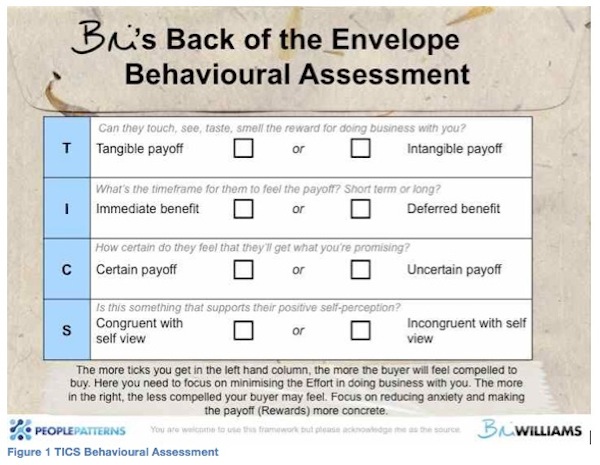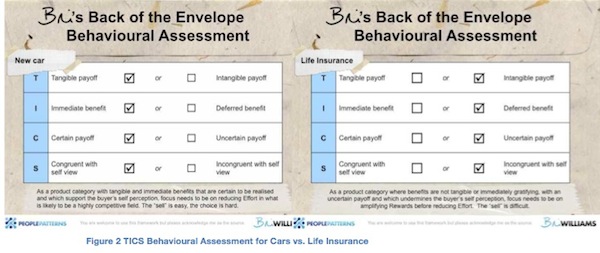A back-of-the-napkin equation that will identify why your conversion sucks
Share
As a marketer, one of the trickiest parts of working out how to improve conversion is understanding consumer behaviour and why people are not doing what you want them to do. The answer lies in narrowing down the underlying behavioural cause.
So the first thing I do when I’m engaged to design a behavioural strategy for a client is a ‘back of the envelope’ behavioural assessment of the product category in which they are competing for buyer attention.
This framework is one you can use to get your head around why your online and offline conversion isn’t where you want it to be.

There are four components to the TICS framework (see note 1) and in this article I’m using products from two categories to highlight the differences: cars and life insurance.
T is for Tangibility
Humans gravitate to things that are real. It’s a greater leap of faith to buy a promise than it is a ‘thing’. Just think how hard online retailers need to work to overcome customer anxiety about sending payment into the ether compared with a shopfront retailer who can hand over the goods there and then.
Tangibility is an assessment of how tangible the payoff for buying the product or service is. Can they touch, taste, smell, see, hear the benefits? A new car is tangible, life insurance isn’t. After all, you can’t wrap your hands around ‘peace of mind’.
I is for Immediacy
Humans are motivated by instant gratification. We love getting good stuff now and leaving bad stuff till later. How soon does your customer feel the benefits of your product? For a new car, it’s as soon as they get the keys. For Life Insurance, the payoff is (hopefully) way down the track – if not never!
C is for Certainty
When it comes to buying something, customers like to know that the payoff will actually be delivered. Ambiguity evokes anxiety so the clearer the outcomes the better. A new car is unequivocal whereas the life insurance category suffers from a (perhaps misguided) perception that policies won’t be paid out.
S is for Self perception
How well does your product fit with the customer’s self-perception? Humans seek an alignment between their values and behaviours, and will often adjust their values to remain congruent with something they have done. When it comes to buying something, customers need to ensure it fits with their internal narrative about the person they are. A new car is likely to support a positive self-view (‘I deserve it because I work hard,’ ‘It’s for the safety of the kids,’ etc) whereas life insurance can jar with positive sense of self. In this case, ‘I’m a good person for looking after my loved ones when I die’ needs to overcome the tension of imagining yourself dead.

How do you stack up?
Once you’ve completed the assessment you will get a feel for where your main consumer behavioural problems lie.
Happy days, I’m mainly in the left-hand column!
You most probably sell products rather than services, or the services you sell have obvious outcomes (like hairdressers or accountants rather than hypnotherapists or health retreats) and what you sell is likely well understood or familiar. There’s good news and bad.
The good news is that you have a stronger behavioural proposition to work with. The bad news is that you are at great risk of undifferentiated competition (easier to sell = more attractive to sell by more people). The focus for you is on minimising the effort involved both in choosing you over others and in transacting with you. In terms of my effort:reward equation (see note 2) concentrate first on effort.
Oh no, I’m mainly in the right hand column!
You might be one of the many professional service firms that find themselves grappling with intangibility and uncertainty (how can I convince someone of the benefits of a health retreat? How can I prove that my marketing proposal will work better than someone else?)
For businesses like these or with products like life insurance where the payoff is distant, ambiguous and perhaps regarded with ambivalence, the focus needs to be on strategies to compensate for this. As far as effort:reward goes, you need to dial up the reward.
While the big ticket payoff might be in the longer term, what can you do to make your customer benefit today? One superannuation fund for example (where the core benefit of having super is deferred and uncertain) gives its customers discounts on insurance policies, bringing a benefit into the immediate term.
What now?
This is where the magic happens. Sorry, that’s not tangible enough is it? The next layer to turn this into an actionable behavioural strategy is to overlay two things:
1. Costs. We’ve so far covered how the buyer may regard your product in terms of the payoff on offer. The other side of the equation is the cost. For example, life insurance not only suffers because benefits are intangible, but gets a double blow when the financial cost of taking out a policy is extremely tangible. Ouch!
2. Behavioural enablers. For every positive and negative identified through the assessment is an underpinning behavioural principle that can be activated to resolve it. For example, to address a lack of certainty that triggers Loss Aversion a business can provide money back guarantees and assurances.
I hope the TICS framework can help you identify the root cause for unsatisfactory conversion performance. If you want more information on how to use it or what happens next, get in touch and I’d be pleased to help.
Notes:
- TICS Framework was developed with a dash of inspiration from Phil Barden’s excellent book Decoded where he covers tangibility, immediacy and certainty, albeit with a different spin, and input on the role of self worth from the very clever and highly recommended team at FiftyFive5 research, with whom I collaborate.
- Effort : Reward equation = When E>R behaviour won’t happen. When R>E you will succeed. More background available on my blog.















